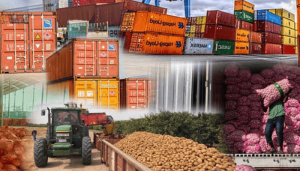Nigeria’s Agricultural Exports Rose by 11% Quarter-on-Quarter and 65% Year-on-Year in Q1 2025

FBNQuest MB Research examines the Q1 2025 Foreign Trade Report released by the National Bureau of Statistics (NBS) today, with a particular focus on Nigeria’s trade performance in agricultural commodities.


According to the data, agricultural exports rose by 11% quarter-on-quarter (Q-o-Q) and 65% year-on-year (Y-o-Y) to N1.7 trillion in Q1 2025. Consequently, agriculture’s contribution to total exports increased to 8.3%, up from 7.7% in the previous quarter.
On the import side, the total value of agricultural goods declined by 5% Q-o-Q but grew by 13% Y-o-Y, reaching over N1 trillion. This resulted in an agricultural trade surplus of N668.3 billion, extending the positive trend that began in Q1 2024.
The sustained surplus largely reflects the effects of naira depreciation, which has boosted naira-denominated earnings from agricultural exports.
- In Q1 2025, Nigeria’s major agricultural exports included standard quality cocoa beans valued at ₦719.9 billion, superior quality cocoa beans at ₦507.3 billion, and cashew nuts in shell worth ₦157.6 billion.
- Europe was the primary destination for Nigeria’s agricultural exports during the quarter, accounting for ₦1.1 trillion, followed by Asia with ₦431.1 billion.
- On the import side, Nigeria sourced most of its agricultural products from Europe (₦406.8 billion), followed by the Americas (₦311.8 billion).
- Following the rebasing of Nigeria’s GDP using 2019 as the new base year, agriculture’s share of GDP increased to 27.8% in Q1 2025, up from 24.64% under the previous calculation.
- Despite this, the sector recorded weak growth of just 0.1% year-on-year in Q1 2025, a notable slowdown from the 2.5% growth posted in the preceding quarter.
- Structural challenges such as insecurity, poor infrastructure, and systemic inefficiencies continue to constrain the sector’s growth and productivity.
- Going forward, tackling persistent security issues in key agricultural regions remains essential for boosting domestic food production and advancing toward food self-sufficiency.








